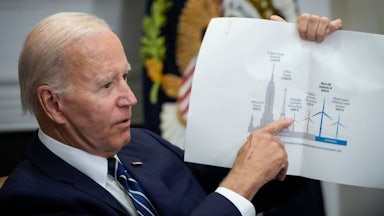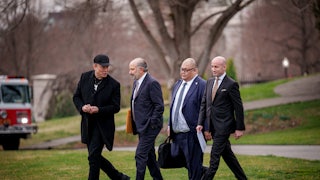In April, the Facebook group “Protect Our Aviation & Eagles, Inc.—Palo Alto County, Iowa” posted a meme to share with its followers. “I SAW SATAN LAUGHING WITH DELIGHT,” the meme begins. The text is laid over the image of a man in red face paint with horns. Below the man is a seemingly endless row of wind turbines cast against a red sky, looking like soldiers in an army of darkness rather than a form of renewable energy.
Protect Our Aviation & Eagles, Inc. may sound like a wildlife protection outfit—but the group, which was created last March under the original name Don’t Lose Lost Island, is an outpost for a dedicated group of local activists working to eliminate wind energy in their county, which boasts around 200 turbines. And while the meme is ridiculous, the group has members committed to political organizing: They routinely attend County Board of Supervisors meetings, which they livestream on Facebook.
Over the past several years, as the country has accelerated the transition from fossil fuels to renewable energy, opposition to wind and solar has skyrocketed across the United States. Much of this opposition—especially when it comes to wind energy—has been propped up by those who stand to gain from renewable energy failures, especially the oil and gas industry, and their allies.
But some of the most significant changes at the local level in one of the country’s most wind-heavy states are happening free of any obvious or direct dark money influence. In Iowa, grassroots activists are using the power of social media to help organize to pass policies that will significantly slow the transition to clean energy.
Until recently, Iowa was the poster child for how renewable energy could succeed in a red state. In the early 1980s, Iowa passed some of the earliest policies to encourage wind generation in the country, and it worked: It’s currently the state with the second-most installed wind capacity, second only to Texas, and in July, Iowa got a record 64 percent of its electricity from wind energy. Wind has historically also enjoyed bipartisan support in the state: Iowa Republican Senator Chuck Grassley proudly calls himself the “father” of wind energy for his role in passing a piece of national legislation in the early 1990s that created tax incentives for the industry.
For many Iowans, wind is a welcome force in their state. Some recent polling suggests more than 85 percent of Iowans have a positive view of wind energy. Leasing land to wind farms has meant a significant windfall (pardon the pun) for some Iowans: In 2017, wind farms paid out more than $20 million in lease payments to Iowa landowners. Wind turbines even feature prominently on a new version of the state’s license plate.
“We’ve had wind energy on a relatively substantial scale here now for almost 20 years, and it was being built with almost no comment,” said Kerri Johannsen, the energy program director with the Iowa Environmental Council. “It was sited at the local level, with local folks making the decisions, getting the tax revenue flowing to the counties who were then able to make substantial investments in roads, and bridges, and hospitals.”
But in recent years, local opposition to wind farms in Iowa has grown significantly. According to the Sabin Center for Climate Change Law at Columbia University, which tracks opposition to renewable energy across the country, 10 of Iowa’s 99 counties have passed moratoriums on wind development or new restrictions on where wind projects can be built; nearly all of these county-level blocks were passed in the past four years, with half passed since 2022. Wind projects in several other Iowa counties without current restrictions are also being hotly contested as local groups agitate their governing bodies to adopt policies that would restrict or eliminate wind farms.
Much of this opposition comes alive online, where representatives from different counties gather to pass around wind memes, organize to attend local government meetings, and even raise funds for more resistance. Distilled counted 10 such groups on Facebook alone dedicated to mustering resistance in specific counties or areas in Iowa.
Opposition to wind energy—especially opposition that manifests online—is nothing new. While the industry was still small and growing, much of this opposition was relegated to badly designed newsletters and websites spreading conspiracy theories.
Johannsen said she noticed opposition to wind-based energy on these ideas begin to filter more into Iowa around five years ago, when local groups began to spread misinformation about wind energy more widely. The tense political climate under the Trump administration also helped to turn what was once a profitable source of electricity and jobs for the state into something else, Johannsen said.
“Renewable energy really was always a bipartisan or nonpartisan issue, and rural areas are benefiting from it,” she said. “Then, I think it started to be more politically divisive during that time period, and people started seeing it as a political symbol.”
Just because something is politicized, however, doesn’t mean that the resistance effort consists of only one ideology. Johannsen stressed that she’s seen anti-wind sentiment from all sides of the political spectrum in Iowa. A study of opposition to wind energy from environmental scientist Leah Stokes, published this month in the journal Proceedings of the National Academy of Sciences, found that opposition to wind farms in the U.S. did not necessarily split on partisan lines.
In recent years, oil and gas interests have been jumping on increased opposition to renewable energy—and seeing real success, especially when it comes to wind. On the Atlantic Coast, fossil fuel–funded groups like the Texas Public Policy Foundation and the Cesar Rodney Institute have helped to amplify and astroturf existing smaller-scale opposition to wind projects, pouring money and marketing power into campaigns against wind.
As previously reported by Distilled, these campaigns have led to significant delays and cost overruns for offshore projects. But the media and misinformation produced on the East Coast are having an impact thousands of miles away in Iowa.
Facebook group organizers and passionate anti-wind activists regularly share memes, articles, and videos between groups. A single video of a wind turbine on fire or the link to a widely debunked study on “wind turbine syndrome” can quickly spread to dozens of groups around the country.
Unlike what’s happening on the East Coast, Iowa’s new wind resistance appears to be free of fossil fuel money, however. No local reporters have yet flagged the presence of outside influence or out-of-state cash to fund opposition groups. Four of the county-level groups provide instructions on their websites or Facebook pages for people to send donations; while two of these groups say they are registered nonprofits, none of their tax forms are publicly available. (The organizers of these groups did not respond to a request for comment from Distilled about where the money goes, or whether they have received any out-of-state donations.)
But even without direct financial influence from polluting industries, anti-wind misinformation is transforming local politics in towns and counties across Iowa. In Fremont County and Page County, activists brought lawsuits this year against their county boards to fight wind ordinances. In Tama County, organizers of an anti-wind group gathered more than a thousand signatures to successfully put a measure on the ballot last year to increase the number of county supervisors from three to five, to bring “additional viewpoints” to the county board; the measure passed easily last year. In Madison County, where lawmakers passed a moratorium on new wind development in 2021, local politics has become all about wind opposition.
“In 2018, the county supervisor candidate who ran openly opposed to further industrial wind development won most of the votes, and in 2020, both the Democrat and Republican candidates who ran openly and unequivocally opposed to this each won their respective primaries,” board supervisor Heather Stancil told the Des Moines Register in 2021.
Iowa is a big state, with 99 counties and a significant, decades-long foothold for the wind industry; it’s going to be tough even for the most dedicated activists to derail the renewable energy transition underway. In Palo Alto County, the Board of Supervisors voted last year to put only minor changes in place to that county’s new wind ordinance, despite the passion of the anti-wind activists who livestreamed the meeting.
But activists have proven that the politics of wind energy can quickly change, even without significant funding from opposing industries. Lease payments, tax revenues, and cheap energy aren’t enough to combat online misinformation that can help activate people on all sides of the political spectrum. Those who support renewable energy could learn from the stamina of rural Iowans who show up to regularly advocate at the hyperlocal political level—and who get their neighbors on board too.
This article was originally published on Distilled.










